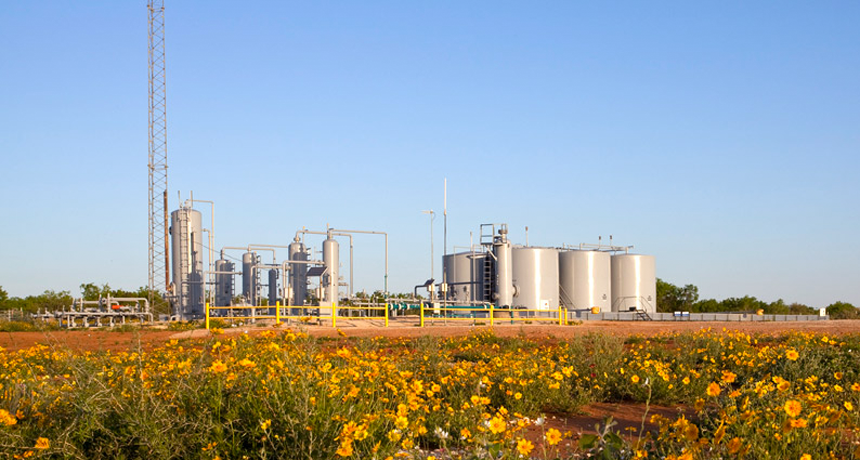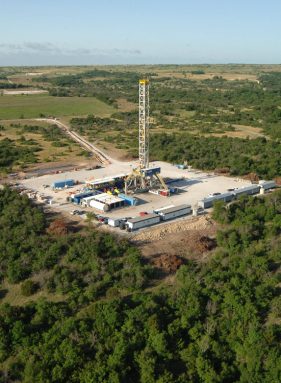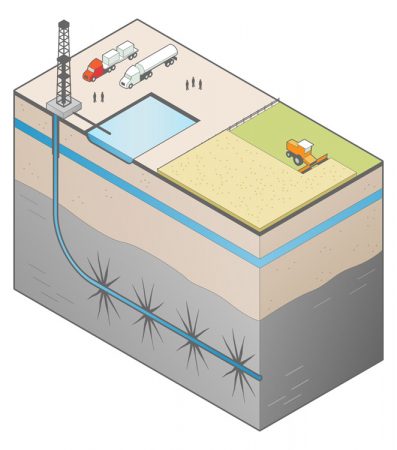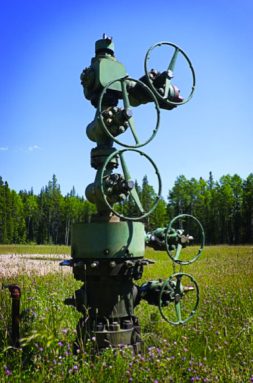Fracking fuels energy debate
The hydraulic fracturing, or fracking, of deep shale deposits is unearthing a lot of natural gas — and controversy

This site has been drilled and fractured and is now producing gas.
ANGA
By Erica Gies
In the 2010 documentary Gasland, Colorado resident Mike Markham strikes a cigarette lighter next to his kitchen faucet. He turns on the tap. Then he waits a beat. Whoosh! A fireball shoots from the flowing stream.
It’s a dramatic scene in a film about a technology being used to unleash huge new supplies of natural gas.
Josh Fox is the movie’s director and writer. He argues that the tap water flames were likely fueled by methane. That’s the energetic molecule that makes up most of the fuel that is known as natural gas. Fox suggested the methane had leaked into Markham’s water supply. How? He suspects it happened as energy companies were extracting the fuel from nearby underground deposits.
Energy companies gained access to that gas through a process called hydraulic fracturing, or fracking. This technology has the potential to open up new underground reservoirs of an important fossil fuel. This natural gas burns more cleanly than coal or oil.
Fox and other critics argue, however, that fracking also introduces new and potentially dangerous environmental risks. The gas industry and a number of scientists disagree. They argue that fracking is not new and that, if done appropriately, poses no major risks.
What’s more, a government agency in Markham’s statechallenges the claim that any methane escaping from Markham’s water came from gas deposits. This Colorado Oil and Gas Conservation Commission issued a report in 2010. It described evidence suggesting that underground coal seams might be the source of methane in the homeowner’s water, not a fracked gas deposit.
Such claims and counterclaims about fracking have dominated U.S. energy news since early 2011. And it’s been generating plenty of heat. The safety of this technology, whose use has grown dramatically in the last few years, is not settled. But scientists’ studies have begun to suggest that gas production can be quite polluting, especially if it’s not managed carefully.
What is fracking?
Natural gas can be used to heat houses, light up a stove or propel a car. The United States derives about 25 percent of its electricity from natural gas, according to the U.S. Energy Information Administration. When burned, methane is cleaner than oil and coal. It also emits less carbon dioxide, a greenhouse gas, and sulfur dioxide, an important air pollutant.

ANGA
To extract natural gas from underground reservoirs, companies use several methods. Which one depends upon the geology of the area. Fracking has recently come into widespread use as a way to get gas out of shale rock.
To frack, energy companies pump millions of gallons of water, chemicals and “proppants” — tiny particles of sand, quartz or ceramics — deep into underground rock formations. The high-pressure liquid cracks apart the rock. Then those proppants hold open the resulting fractures. This allows gas inside or beneath the rocks to flow into pipes and up to the surface. There it is hustled into pipelines.
Some researchers have begun linking fracking to polluted groundwater. To date, science has found conflicting results.
But that’s not the only concern. In recent months, other scientists have linked fracking to earthquakes.
“Fracking is a case of technology moving ahead of the science,” says Nadia Steinzor. She’s an organizer for Earthworks, based in Washington, D.C. Her group’s stated mission is to protect communities and the environment “from the impacts of irresponsible mineral and energy development.” Lately, her group has taken a special interest in fracking.
At a meeting of the American Association for the Advancement of Science (or AAAS) in Vancouver, Canada, last February, scientists agreed there was a need for more research on fracking. Many researchers are currently studying ways to frack more safely. And new studies are coming out regularly, helping environmental and energy engineers better understand the impacts of fracking.
But a number of researchers now argue that the problem is not the fracking used to open up a gas reservoir. Instead, they charge, the problem comes from efforts to bring that gas to the surface via wells. Indeed, much of the pollution being linked to gas production can occur more than a kilometer above where the fracking took place. That suggests that pollution associated with this gas comes from poor management of gas-production wells or of wastewater, says Charles Groat. He’s a researcher at the University of Texas at Austin. His team found similar results, which he presented at the AAAS meeting.
Given these findings, he said that focusing on fracking may distract people from making sure gas producers improve the seals on their wells’ piping — what could be the main source of pollution.
New interest in old technology
The company Halliburton claims it invented fracking in 1947. But the U.S. Energy Information Administration says that experimentation with the technique began at least a half-century earlier. In the 1970s, energy companies partnered up with the U.S. government to develop new techniques to reach natural gas deposits in underground rock formations. Only in the last decade, however, has use of these new techniques really taken off.
Companies have been getting much of their new supplies of gas out of a sedimentary rock called shale. It formed from tiny particles of minerals and dead plants and animals. Millions of years ago, those particles settled to the bottom of rivers, lakes and oceans. Over time, they became compressed and eventually developed into rock.
Key to making shale gas accessible has been a new technique known as horizontal drilling.
In the past, gas companies drilled wells straight down into the ground until they broke into the top of a gas reservoir. Then they installed a pipe into the opening, sealed the outside of the piping at the base and sealed all segments of the pipe up to the surface.
But now companies have begun opening a hole down to a certain depth and then turning their drill bits at a 90-degree angle. They then bore through rock horizontally, or sideways. Combining this horizontal drilling with hydraulic fracturing suddenly made it possible to reach rich supplies of previously unavailable shale gas.

M. Mathis/iStockphoto
Shale formations that contain natural gas exist throughout the United States and other countries as well. The Marcellus Shale deposit is the largest U.S. formation. Much of it stretches beneath parts of New York, Pennsylvania, Ohio and West Virginia.
In the last few years, fracking has dramatically increased natural gas production from shale in the United States. By how much? A whopping 48 percent a year between 2006 and 2010, according to the Energy Information Administration.
Water pollution
Gas companies are trying to reduce the amount of water they use in fracking, both to conserve this precious resource and to reduce the traffic associated with trucking in water to a new drill site. But current practices may be polluting reservoirs of water already in the ground that will be used for drinking.
Critics like Nadia Steinzor, landowners like Mark Markham and some scientists question whether companies should be doing any fracking before science shows whether or not it poses risks to drinking water supplies.
In the scientific process, scientists conduct studies and experiments and propose explanations for their results. They also continuously re-evaluate their own and other scientists’ work. This process is important to arrive at correct answers. But it can take years or even decades for a clear answer to emerge.
Markham and other people have reported problems with their drinking water after gas companies conducted fracking nearby. Yet underground reservoirs holding natural gas typically lie at depths of about 0.9 to 2.7 kilometers. Groundwater supplies are much more shallow, from a couple of meters to a couple of hundred meters below the surface.
Scientists have recently begun to investigate whether methane or fracking chemicals can leak out of piping or other gas-extraction equipment and into those groundwater supplies during shale-gas production.
In 2011, researchers from Duke University found methane contaminating private drinking-water wells near fracking operations in Pennsylvania and New York. “People noticed their water fizzed, like if you drink Alka-Seltzer,” as it came out of home faucets, says Stephen Osborn, who led the Duke study. “The water would sputter. It would start to come out, stop, then start again.”
Osborn and his fellow scientists found that the water from wells within 1 kilometer of fracking sites had much higher levels of dissolved methane than water from wells farther away. The researchers also studied the methane’s chemical fingerprint and found that it precisely matched gas from nearby fracked wells and underground shale formations.
But gas companies insist that most fracking happens so deeply underground that it could not possibly contaminate groundwater supplies, which tend to lie relatively near the surface.
Osborn’s team ultimately concluded that the methane they detected in local people’s drinking water likely came not from the hydraulic fracturing of rock but instead from leaky pipes used in the well to bring gas to the surface.
That was similar to the basic conclusion that Groat’s team presented at the AAAS meeting earlier this year. They also found no link between flammable tap water and fracking. Instead, they traced groundwater contamination to other activities associated with gas extraction. These included spilling drilling fluids on the surface or mishandling wastewater, which is often pumped deep underground for disposal.

The U.S. government already regulates gas extraction, but not fracking. In 2005, an energy company successfully pressured the U.S. government to make fracking exempt from regulation. But because the science so far has been unclear on whether fracking itself causes groundwater pollution, new laws to regulate fracking may not be necessary, Groat says. Instead, he argues, more government policing of existing rules may be needed to prevent further pollution.
Mystery pollutants and possible earthquakes
People who live in communities near fracking operations have also raised concerns about chemicals used. Typically, community residents never learn what these chemicals are. Drilling companies usually choose to keep them secret, arguing that revealing the recipe for their fracking compounds might allow competitors to copy it. And this could save their competitors lots of money, giving them a business advantage.
However, this past May the Obama administration proposed a new law that would require companies to divulge this information, at least when drilling on public or Indian lands. Prompting this proposal was a draft report released in December by the Environmental Protection Agency, or EPA. It found at least 10 known fracking chemicals in groundwater near Pavillion, Wyo., a rural ranching town. The groundwater is the primary source of water for homes, the city and livestock. EPA researchers concluded that the contamination it found most likely seeped up from gas wells near Pavillion.
Scientists led by Theo Colborn of The Endocrine Disruption Exchange in Paonia, Colo., published another study in 2011 in the journal Human and Ecological Risk Assessment. It found that fracking chemicals can be dangerous to human health. The researchers compiled a list of 632 chemicals used in natural gas operations. Then they evaluated research that other scientists had done on more than half of the chemicals to evaluate whether exposure to them might hurt people.
Colborn’s group reported that at least 3 in every 4 chemicals they examined could affect breathing systems, the gut and several sensory organs, including the skin and eyes. Roughly half might affect the brain or nervous system, immunity, the kidneys and the cardiovascular system. And perhaps 1 in 4 of the chemicals “could cause cancer and mutations,” that report concluded.
“The health science community is now looking at why health complaints are rising in fracking areas, particularly among children,” says Steinzor of Earthworks. She says that some people who live near fracking areas have been complaining of headaches, nausea, bloody noses and nerve problems. As a result: “New studies are delving into the pathways of exposure and what levels are dangerous.”
Finally, a troubling new concern has emerged in the past year: earthquakes. The U.S. Geological Survey has begun linking the hydraulic fracturing of rock deep underground and the disposal of fracking wastewater with small earthquakes. When the fluids flow into cracks within the rock, they can create a bit of wiggle room that frees one rock slab enough to let it slide past its neighbor. That ground motion is an earthquake.
Recent small earthquakes in Arkansas, Ohio, Oklahoma and the United Kingdom have occurred at sites near fracking operations. Such earthquakes are felt by many people but rarely cause damage. Bill Ellsworth and his colleagues at the U.S. Geological Survey reported in April at the Seismological Society of America meeting in San Diego that the Arkansas and Oklahoma quakes are “almost certainly” related to gas production.
In June, a study by the National Research Council reported that fracking itself is unlikely to cause earthquakes big enough for people to feel. What’s more likely to produce notable tremors, it concluded, was the injection underground of wastewater from fracking operations.
Although controversy over fracking will continue for years, it’s important to realize that producing energy from any source usually involves some degree of pollution.
As Osborn sums it up: “People all need clean drinking water. Modern society also needs energy.” He says that there just “needs to be a balance drawn between protecting water resources and providing energy for our computers and cars.”







